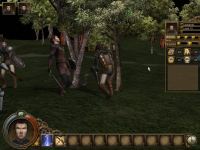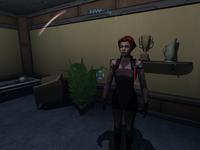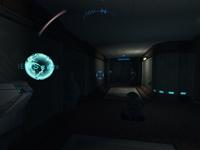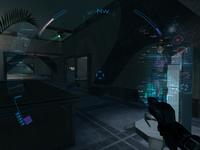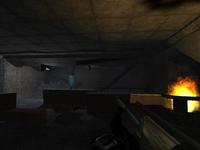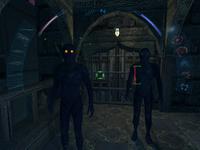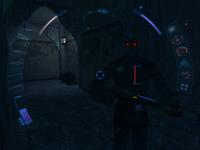|
|
|
Main News Forums Games Games Database Top 100 Release List Support Files Features Reviews Previews Interviews Editorials Diaries Misc Download Gallery Music Screenshots Videos Miscellaneous Staff Members Privacy Statement |
Deus Ex: Invisible War (PC) Review
Deus Ex received many awards when it was released in 2000 with its blend of first-person action, multiple solutions, RPG elements and a dark dystopian future world. It wasn't the first game to introduce these attributes, having been preceded by at least System Shock but JC Denton's struggle against a near-future global conspiracy really struck a chord with players. Now the story continues with the highly-anticipated but controversial Deus Ex: Invisible War.
Factional Politics The player is cast into this world of conflict as Alex D - a trainee operative at a security and covert anti-terrorism school called the Tarsus Academy. After a terrorist attack destroys Chicago, Alex D is relocated to the Tarsus facility at Seattle. You begin by choosing a male or female character and one of three faces (actually the same face with three different colours). There's an immediate attack on Tarsus and after briefly meeting some classmates you escape to the streets of Upper Seattle where the game proper begins.
And this is where a major departure from Deus Ex becomes apparent. Rather than a linear mission structure, different factions will contact you directly and vie for your attention with their requests. In most cases, their tasks are accepted automatically and added to your datavault but whether you choose to complete them or not is often up to you. This is quite an exciting addition and obviously one of the core changes Ion Storm has made to the gameplay.
Often these tasks conflict - you may be asked to obtain information about a research project from a scientist by one faction and to kill the scientist to slow the work by another. It's up to you to decide which path to follow and which factions to support. DX:IW deliberately maintains a conspiracy-ladden atmosphere - a world with no obvious right or wrong. You'll be given reasons to doubt each of the factions and they'll attempt to undermine any confidence you have in the others.
More importantly, the factions don't react to your choices. Oh, they'll send you a message indicating how disappointed they are you sided with the opposition - but then they'll give you a new task. Even with goals that are mutually exclusive, factions will continue giving you tasks no matter how many times you cross them. Early in the game I entered a restricted WTO area (who I was nominally supporting) against their orders. I got pinned down and had to shoot my way out but I shouldn't have worried about the effect - as soon as I left that area no one reacted to my rampage. In fact, I walked out the heavily guarded front door and the guards didn't bat an eyelid. Perhaps you could assume they didn't know about my misdeeds except the instant you complete most goals you'll be contacted by multiple factions, so everyone seems quite capable of monitoring your movements. After a while, there's a good chance you'll complete as many goals as possible without being too concerned about which group it's for or the consequences. It's a pity a game about choices makes them rather hollow.
World Travel DX:IW is largely based around "hub" levels. Major levels such as Upper and Lower Seattle are central locations from which the player has reasonable freedom to travel to connected areas as they wish to explore or pursue quests. These areas are mostly dark and gritty urban sci-fi environments that succeed in creating a suitable atmosphere. Unfortunately they're generally smaller than in Deus Ex and have a closed-in, claustrophobic feel. Seattle doesn't so much feel like a city as a single shopping mall and one slum block. Even more annoying is the constant loading: walking across Seattle for a quest may entail four or five loads as you enter the different areas. The hub design together with the different factions does provide some degree of non-linearity (and certainly more than Deus Ex) but there's not a lot of depth to it. Not too far into the game I was ordered by one faction to hire a helicopter and fly to a weapons plant to investigate a matter. A few minutes later the main rival faction contacted me with a similar request (albeit with different motivations). There's a veneer of freedom but ultimately it funnels the player to the same spot.
Often you will be immersed in the atmosphere created by this world of secretive organisations with it's seedy undercurrent. However, a number of oversights take their toll on the immersion. For example, despite the complete destruction of Chicago by terrorists, an attack on Tarsus and the threat of more action from splinter groups, no one reacts to you brandishing a weapon in public. You can also steal things right in front of people without any reaction. When the game starts you can hear the muffled explosions of the attack on Tarsus rumbling through the building and a guard is killed in front of you from a ruptured pipe. Coming across classmate Billie Adams, she tells you to hurry along but she's got some things to do. There's an attack on the building but she has to reorganise her stamp collection? No Skills? DX:IW does away with a skills system altogether. Unlike Deus Ex, your ability to aim accurately operates the same way as any other shooter. Success at picking a lock or bypassing a keypad is only dependant on having enough multitools (lock picks have been rolled into multitools). Hacking a terminal requires a Biomod - but once you have it success is 100% (although upgrading provides more functions). Biomods are the key to character customisation in DX:IW. There are five Biomod slot locations (the sixth is reserved for a light and can't be changed) with three choices for each location - two standard and one "Black Market". Only one choice can be installed in a slot but they can be upgraded to level three with upgrades generally reducing the energy consumption or improving the effect. Unlike Deus Ex, Biomod canisters are universal and can be used in any slot (although Black Market canisters can't be used in a standard slot and vice versa) and don't require a Medibot to install. You can also overwrite an existing Biomod with a new choice, although that discards the existing canister. There's a reasonable range from strength mods that improve melee attacks to stealth mods that mask you from organic beings or machines. I particularly enjoyed using the various drones, which have some pretty cool functions. Without skills and with three Biomods early in the game it's pretty easy to build a fairly well-rounded character with enough non-combat mods to choose your approach for each encounter. Biomods are readily found and before the halfway point you're likely to have a full compliment installed. This simplification will suit some players but it strips away any real pretence at being a RPG and lets players off too easily: there's no hard choices about the type of character they want to build or even how to survive a particular encounter with the limited abilities at hand. A world of Ventilation Shafts
Fortunately (or unfortunately), the world of DX:IW has a ventilation shaft next to every secure point. It might be hidden behind a box but it's there. While this accommodates different solutions there's not a whole lot of skill or thought required to avoid an armoured checkpoint by crawling through the conveniently provided grate. Remind me to start a company that sells ventilation grates with locks - I could make a killing in the world of the future. What's more, some of the stealth-oriented weapons are a farce. The stun-prod is ludicrous as the victim screams in agony from the loud electric zaps as you desperately use it again and again before it's effective. Batons and crowbars are a little more useful but it still takes too many strikes to subdue someone. Even post-patch it takes at least three direct headshots with most guns to take down a guard. The only effective, quick takedown weapon is the sniper rifle when zoomed. Get caught unexpectedly with the sniper rifle though and it still takes three headshots if you don't use the zoom. Eh? Without the Skills system to encourage any sort of real specialisation and with pretty easy combat for the most part, there's little reward for sticking with a non-combat style of play - other than it's even easier to just crawl through the conveniently provided vent. Artificial Unintelligence Action-oriented play fairs better. In this regard, DX:IW plays like most shooters and has some exciting moments but the simple AI does it's best to reduce the experience. Enemies will tend to run straight at you or investigate fallen comrades for an inordinately long time allowing you to easily pick them off. Interestingly, some of the enemies towards the end roll and duck and generally seem to have better AI; this makes you wonder if the AI isn't so much "bad" as deliberately restricted to reduce the difficulty. This is where the unified ammo becomes irritating. DX:IW uses a single universal ammo pool - each weapon depletes the same pool. To balance this, more powerful weapons use more ammo. Ammo is in reasonable supply but the bigger weapons chew through it at such a rate that they're often impractical. Once you've run out of ammo, you can't even switch to the useless stun-prod because it uses the same pool.
Eyeballs and Interfaces The interface in DX:IW has been completely remodelled. The main HUD is designed to look like a projection onto the eyeball with the curved bank of a six-item "toolbelt" on the left and six Biomod icons on the right. It might be an attractive concept but it takes up too much space and obscures the visible area despite the semi-transparency. Still, you'll get used to it after an hour's play. It's hard to avoid the feeling that the icons are so large so they can be seen on a TV. What takes more getting used to is the replacement of Deus Ex's drag and drop inventory with a total of twelve slots (including the six visible on the HUD for the toolbelt) where a flamethrower occupies a single slot just like a multitool. These slots use a rather silly system of selecting one item and then another to swap them between the inventory and the toolbelt. The limited number of slots means you'll need to be selective about which equipment to keep, although some items stack and the strength Biomod provides a few more slots. Technically Speaking Graphically, DX:IW can look pretty good at times on a powerful system. The textures are generally good with some nice bump-mapping. It's the dynamic lighting and shadows that steal the show, however. The lighting system casts real, moving shadows that look great. A swinging light bulb or flickering fire is quite atmospheric and you'll often be able to use the lengthening shadows to tell the direction a guard is heading around the corner. Perhaps to accommodate the power required for the lighting, objects often use fairly low poly counts, which can be distracting along with the occasional average texture. Characters models are particularly variable - many of them aren't very good and strangely the protagonist Alex D is one of them. The character art style is less realistic than Deus Ex and not to my taste and the tomato-sauce blood effect looks goofy. Unfortunately, slower systems will find it hard to get a balance between eye-candy and good frame-rates and I experienced minor texture glitches on both the systems I tried it on. The sound in DX:IW is good but not outstanding. The voice-acting quality is variable but probably better than average. The sound effects are quite good from the various weapons through to robots although explosions could do with more depth. The environmental sound is effective in the small, dark spaces you'll often be in but the city areas lack a certain "bustle" that makes them a little lifeless. The music is similar to Deus Ex with an ambient new-age soundtrack but inexplicably it faded into the background within a few minutes of starting play on many occasions for me. It's hard to know if this is a bug or deliberate design but I would have liked to hear more of the music and in particular a good combat theme would have added some nice tension.
Compounding some of these issues is the game length: my first run through was around 12 hours and the second under eight. A longer game might have given more opportunity to develop the faction system. There are multiple endings that are worth seeing but the choices that trigger these are very, very, very late in the game. In Conclusion Ironically, as the game progresses it becomes more linear and the story gets a chance to shine. A few of the levels have excellent designs and at times you'll be totally absorbed - almost reminiscent of the original Deus Ex. The story is often good and it's a shame DX:IW couldn't harness this and an open-ended faction system in a compelling way at the same time. For a game that aims to provide an unprecedented level of freedom in how players approach the game, DX:IW tries too hard to be accessible and ends up diluting the experience. It's the consequences that make choice meaningful and DX:IW avoids those consequences at every opportunity. It has a compelling story in an interesting cyberpunk world and that will be sufficient for some players but otherwise it's diminished from the original in almost every way.
Rate this title and view comments Game Info Printer Friendly Version |
|||||||||||||||||||||||||||||||||||||||||||
|
All original content of this site is copyrighted by RPGWatch. Copying or reproducing of any part of this site is strictly prohibited. Taking anything from this site without authorisation will be considered stealing and we'll be forced to visit you and jump on your legs until you give it back. |
||




